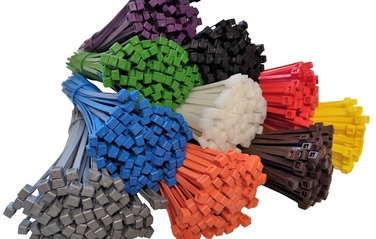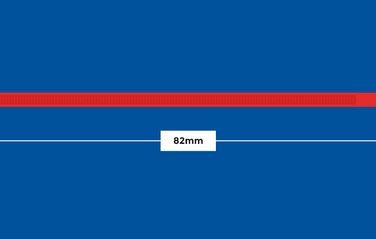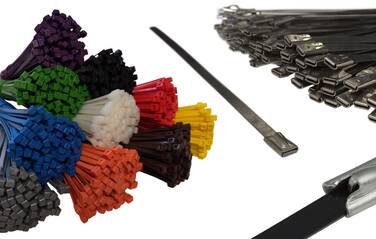From securing bundles of cables, to having to withstand the most extreme of environmental conditions, the cable tie is an indispensable part of our lives. But how are they made and where are cable ties used?
What are cable ties?
Cable ties are bands or straps manufactured from nylon or stainless steel, or a combination of the two, that are used primarily to bundles wires and cables together. Invented in the 1950s, cable ties were originally designed to help manual workers in the aircraft industry and were patented under the brand name Ty-Rap.
Nylon cable ties
Nylon is the most common material used in the manufacture of cable ties and at cableties-online, our cable ties are made from nylon 6/6. This refers to the chemical structure of the nylon; our blog article What are cable ties made of? examines the science behind the types of nylon. Variations of the standard nylon 6/6 cable tie include releasable cables ties, UV and heat stabilised cable ties, screw mount and push mount cable ties, chassis mount cable ties, and marker cable ties.
Stainless steel cable ties
Stainless steel cables ties are used in situations where nylon ties would not be suitable, such as extreme heat and severe environmental conditions. We use 316 stainless steel for our ties, for its high melting point (1375-1530°C / 2500-2785°F) and its strength . We supply standard stainless steel cable ties as well as PVC and epoxy resin coated metal cable ties which reduce the risk from scratching and abrasion. Our metal detectable cables ties, while being nylon 6/6 do have a metal content that can be picked up by scanning equipment.
How cable ties are manufactured
Cable ties are manufactured by injection moulding, a process that allows identical parts to be made in large quantities by injecting a liquid material into a mould. With nylon cable ties, nylon 6/6 pellets are introduced into the moulding machine and heat is applied to melt the pellets. As the molten nylon cools, it hardens to take the shape of the mould. The mould is then opened, once the cooling process is complete, and the ties removed.
Which manufacturing industries use cable ties?
Cable ties have many applications and are so versatile that they are used in almost every industry, from the aerospace industry to the fast-food industry and everything in between. Any industry that involves the packing and shipment of goods will use cable ties and where products are subjected to scanners or metal detectors, for example the food and pharmaceutical industries, the metal detectable cable tie comes into its own. Coloured cable ties and marker cable ties are used to facilitate locating, loading and unloading. Off-shore industries too will use stainless steel cable ties for their resistance to salt water and corrosion, while their heat and chemical resistance makes them invaluable in the aviation and petrochemical industries. Our article ‘Applications for cable ties’ has lots more information.
How to store cable ties
To ensure maximum efficiency, cable ties must be stored correctly. Cable ties should be kept in cool, dry conditions to prevent disintegration or oxidation and where possible, ties should be kept flat to avoid them bending.
If you have any questions about any of our cable ties, our staff is always happy to help. We can be contacted by phone on 01623 706241 or by email at sales@cableties-online.co.uk








